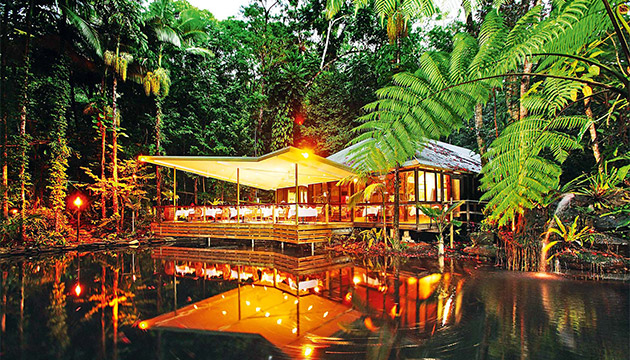The world’s oldest rainforest isn’t only enticing for its trees – there’s also 40,000 years of Aboriginal culture and an eco lodge that brings the two together.
Story By Fleur Bainger
Mention Queensland's Daintree and most people think of vast stretches of World Heritage-listed rainforest glistening with teardrops of water that splash from green leaves to mossy boughs. Few realise that locked within the dense vegetation and tied inexorably to the country is the world’s oldest living culture, that of the Aboriginal people. The Kuku Yalanji have inhabited these lush surrounds for tens of thousands of years. This ancient culture continues to coexist with the most ancient rainforest on the planet – at 135 million years old, the Daintree is 65 million years older than the almighty Amazon.
At Daintree Eco Lodge and Spa, a family-owned rainforest resort nestled north of Cairns, visitors are granted a window into the deep Aboriginal knowledge of the Daintree, and the traditions still maintained within it.
Staying at one of the resort’s 15 towering tree houses – all named after native animals by Indigenous elders – the connection to the traditional owners is evident everywhere, from the many Aboriginal staff employed throughout the grounds to the native food-spiked menu at the on-site Julaymba restaurant and the Indigenous art gallery running down one side of it.
The Kuku Yalanji’s culture is shared on an Aboriginal-guided walking track within the lodge’s 12-hectare property. Ronald ‘Bama’ Bamboo is one of the descendants who leads groups through the sprawling, moist greenery. Bama, he says, is the name for Aboriginal men of the rainforest. He has been sharing his ancestors’ traditional ways and stories with the lodge’s guests for the past three years.
“My grandparents used to teach me everything around this part of the area,” he says. “They’d take me out camping; I’d go gathering with my grandmother and hunting and fishing with my grandfather.”
As he walks past some of the Daintree’s 3000 plant species, he points out numerous fishing tools. First, there’s the root of a plant that, when crushed, will attract fish. “We call the fish to us,” Ronald says in his gentle voice. Next, he motions to a tree whose wood is perfect for making canoes, and then he reveals the menacing-looking ‘wait awhile’ needle plant, which makes itself near invisible until its victim is just centimetres away from its painful embrace. Ronald says Indigenous women would use its spiky boughs as fishing line, catching several hapless fish on one branch. “We didn’t have a tackle box,” he says with a cheeky grin. Pointing at the rainforest, he says, “But we’ve always got our store right here.”
This story excerpt is from Issue #80
Outback Magazine: Dec/Jan 2012










